Improving Mathematics at High Tech High with Improvement Science
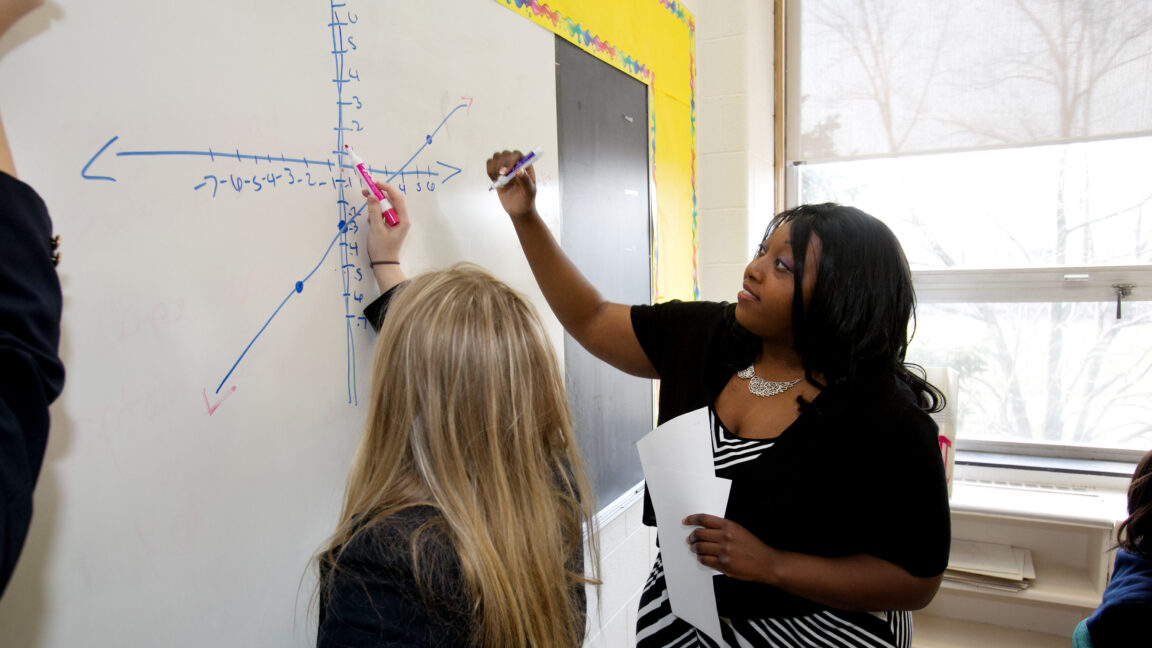
“When mathematics is taught as an open and creative subject, all about connections, learning, and growth and mistakes are encouraged, incredible things happen.” (Boaler, 2016, p. 20)
“What is the math like around here?”
We, all current or former math teachers at schools in the High Tech High organization, have been asked this question, again and again, by hundreds of parents, prospective students, visitors, and teachers. And, three years ago, answers to this question were highly inconsistent.
High Tech High is a progressive public charter school in southern California with a focus on providing every student what they need to succeed in college and life through project-based learning. In response to the question above, we found we could point to some evidence of high-quality project work, student achievement, and promising instructional practices in our schools—but we were unable to match our math classes with the ways other classes at our schools were interpreting our organization’s vision of equity, personalization, authentic work, and collaboration. These design principles drive our schools, and we each value them highly. So what was causing the mismatch for our math courses?
Conversations circled between stakeholders. Some pointed to high-stakes tests that stifled creativity. Others lamented the limited ways that colleges sort incoming students into “math-ready” and “not-math-ready.” Still others described their perceptions of students’ expectations about how math class should be structured, or the culturally pervasive belief that the best way to teach math is to be good at explaining things.
Clearly, we needed more support to build better math classes. Our first breakthrough came from reading Jo Boaler’s book Mathematical Mindsets and attending a conference she hosted. In Boaler’s work, we found robust, inspiring descriptions of how a math classroom can make math rigorous, creative, rich in connections, and driven by equitable structures. What wasn’t yet clear to us was how to plan or evaluate our next steps towards the type of classrooms we envisioned.
Happily, our organization was selected to participate in the Knowles Teacher Initiative’s Project ASCENT (Achieving STEM Course Effectiveness Through Networked Teachers). ASCENT connected us to a network of teachers around the country using improvement science, an idea made popular by the Carnegie Foundation, that empowers teachers with tools and strategies to make small incremental changes in their classrooms. Our network’s goal was to work on increasing the number of high school students experiencing high-quality science, technology, engineering and mathematics (STEM) education.
Our High Tech High team, inspired by Boaler’s work, began by developing a focused aim to improve students’ sense of agency (i.e., growth mindset, belongingness, and value) and their access to college with regards to math. We each found ourselves interested in different aspects of this goal.
• Carlee, a 12th grade teacher, decided to completely revamp her grading system in an effort to offer more helpful feedback to improve both the mindset and achievement of all of her seniors.
• Will, a 12th grade teacher in our organization, was interested in the idea of equitable access to college-level math and the often-frustrating ways that students are placed into, or not into, these classes at colleges and universities. He was invited by administrator Ben Daley to begin exploring ways of getting students out of remedial collegiate math by offering a college course with Will’s support during students’ spring semester of their senior year.
• Sarah, a ninth grade teacher, saw her young students often struggled to have confidence in their math ideas. She was interested in warm-up routines that focused on output of ideas rather than correct answers. She was also interested in ways that students could share their ideas and be the mathematical authorities in the classroom during this process.
As we attempted to learn more about students’ experiences in math and how to impact them, we worked in three specific collaborative environments. First, we relied on the ASCENT network to help us create consistent surveys and other measurement tools to collect data on student agency. Secondly, we used our team of High Tech High teachers and administrators to unpack our data in regular meetings and consider how we might use what we learned. Lastly, and perhaps most importantly, our own students were integral in this work as we began regularly sharing data back with them and relying on their input to give us ideas on how to better support student agency.
These three collaborative data-sharing communities were able to elevate the High Tech High team’s math work. In the following three vignettes, we highlight how data sharing and collaboration with different communities led to some big shifts in instructional discussions with colleagues and practices in our own classrooms and, in our final year together, the organization as a whole. We conclude with the ways the improvement structures continue to play out for math in our organization and some tips for teachers on how to start collecting and sharing meaningful data in their own context.
Collaboration with the ASCENT network: Using regular check-ins with shared data to make a large-scale shift in grading
Carlee: The goal of our second meeting with the ASCENT network was using data to center our work. After breaking down the ways our students had responded to the ASCENT-wide survey we’d given about student perception of STEM, our team developed three specific survey questions that would help us understand our students’ sense of agency in our classes. Other teams in the ASCENT network gave us feedback that helped us refine our survey questions. With excitement about consistent data, our High Tech High team committed to giving our survey weekly and unpacking the data together to determine which of our changes were successful in promoting student agency. The questions we committed to asking our students, along with the targeted aspects of student perception probed, are shown in Table 1, and Figure 1 shows a semester-long plot of responses with the data organized by teacher. Such a graph is often called a run chart and is helpful in making sense of trends over time.
Table 1
Targeted Aspects of Students’ Agency and Related Survey Questions
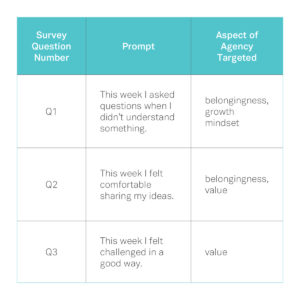
Note. High Tech High math teachers administered a three-question survey weekly to their students. Students scored aspects of their sense of agency in their math classes using a Likert scale.
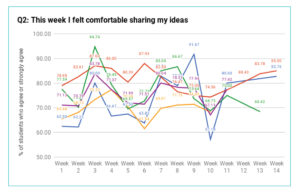
Figure 1. Students’ responses to question 2 recorded over 14 weeks. Change in responses to Q2, as shown in Table 1, graphed over the duration of a semester. Each color in the run chart represents data from one teacher.
We quickly discovered that looking at this common data helped us calibrate success on changes to our classrooms aimed at promoting a growth mindset and intrinsic motivation to learn senior-level math, such as the scoreless grading system I was prototyping in my class (Strong & Hollenbeck, 2017). When the students would answer favorably on the survey in a week when I was attempting a particular intervention (like one-on-one check-ins or accountability buddies), I would pass that idea along to other members on our team to test so we could see how it translated into other settings. When an intervention didn’t get very favorable responses (like weeks with too much reflection time), the team would discuss that together as well and, more specifically, I was prompted to change the type of feedback I gave my students.
The weekly classroom survey was vital because it began to drive my approach to the day-to-day problem-solving I did in the classroom. The questions we designed with the ASCENT network felt so powerful to me that I used them as a framework for collecting qualitative data by asking students to share their thoughts on them as part of grade proposals in our scoreless grading system. For me, being inspired by the network to collect small-scale, consistent data was revolutionary, both in my classroom’s efforts to increase student agency and our work as a team.
Collaboration within the High Tech High team: Increasing student access to college by jumping with students over existing barriers
Will: As the High Tech High team began diving into the idea of student agency and the ways agency is linked to college access, it was integral to look at data both from our organization and from the state as a whole about what types of classroom structures promote students’ success in high school and college mathematics.
At one of our meetings, administrator Ben Daley brought published data strongly implicating math remediation as one reason why students do not complete college. Math remediation is a higher education practice in which students who have not yet mastered high-school-level mathematics are required to enroll in remedial math courses as prerequisites for the math courses required for their degree. After digging into the data, it became clear to us that math remediation was a major problem, a virtual pit that students fall into and never get out. Figure 2 captures the scope of the problem with math remediation in California, our home state.
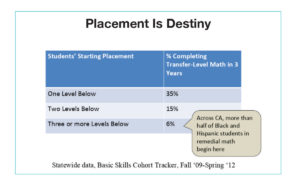
Figure 2. Relating entry-level college math placement and completion of transfer-level high school math. Adapted from “Acceleration: A Powerful Lever for Increasing Completion and Equity,” by K. Hern, 2017, [PowerPoint slides]. Retrieved from https://slideplayer.com/slide/12512410/.
Based on our research, Ben asked me to create our own version of an accelerated pathway system in the High Tech High school where I work. Our goal was to provide all students the opportunity to enroll in (and hopefully pass) college-level courses in English and math at their high school. This would, we thought, allow students the opportunity to develop their skills in both disciplinary thinking and study habits while still being supported by their school’s teachers.
Ben and I quickly began the logistical work of making this program a reality for all of the seniors at my school. We collaborated with all the stakeholders involved and enrolled the majority of our seniors (about 70%) in at least one college class in the spring semester of 2018. During the course, we used our ASCENT improvement team to quickly iterate a variety of interventions by trying new ways to support the students, collecting data, and sharing back on what worked and what didn’t.
Through the iteration process, teachers prototyped and refined procedures for one-on-one check-ins with students, incentivized and supported out-of-class study groups, and co-planned individualized study schedules with students.
Through our research and that close work with students in the class, we also learned that, as has been found nationally (Page et al., 2017), our lower-income students were the least likely of our eligible students to complete the Free Application for Federal Student Aid (FAFSA). The FAFSA is the paperwork that allows students to apply for financial aid to pay for college, and completing it is one of the best predictors that a student will be able to continue an education after high school (Warick, 2017). As a result of our new knowledge, we began to use course time to identify students who needed assistance in completing this important form. Due in part to this work, we have increased low-income-student Cal Grant award rates by 14% in the past two years. One step in the process, on-time FAFSA completion, has increased for low-income students by 16% since 2013, and we are hopeful this will lead to more low-income students graduating from college in the future.
I can’t emphasize enough how valuable it was to keep asking our team to clarify exactly what we wanted to change, why it was important, and how we would know when we succeeded.
We are still waiting to see how participation in the college class affects college retention, but I am optimistic. At the very least, our improvement work provided us deep insight into the problems of remediation and gave us a starting point to focus our efforts and continue to improve. We continue to offer the class but are trying to keep the class size smaller, scaling down to prioritize enrollment for students who are first-generation college-bound, come from low-income families, and/or identify as people of color. We also changed professors to an instructor who deeply prioritizes inclusive classroom practices and pedagogy.
For myself, the benefits of our school’s improvement science work have been twofold. First, working within the structure of improvement science was critical in helping us identify the specific and measurable aim that we wanted to improve. I can’t emphasize enough how valuable it was to keep asking our team to clarify exactly what we wanted to change, why it was important, and how we would know when we succeeded. Creating this clear and common vision was illuminating, motivating, and really helped focus our thoughts and energies.
The second way improvement science helped us was by giving us a clear iterative structure where we as a team could keep coming back to the table with new ideas, sharing them, and trying them out. Having a structure where peers could collaborate and innovate in a systematic way was very helpful to me and, I think, would be helpful to any team. While my students were trying to fill out the FAFSA as well as while they were in the college class, I was constantly experimenting with ways to help them and running these experiments past our ASCENT group. It was thorny, and didn’t feel like a success at every point in the process, but we now see that the work was worth it. I deeply value the improvement science work we did as a team and am excited as elements of it continue to find their way into our school system as a whole.
Collaboration with students: Deploying improvement science authentically in the math classroom
Sarah: A seemingly benign question, “Did you ask the students?”, became the most important reflection for improving student agency in my classroom.
In fall 2017, I decided the focus of my improvement for the first few months would be the warm-up structures in my class. The purpose of the shift was to redirect students’ mindset around math learning by measuring idea generation, sense-making, and sharing out with others as opposed to solely answer getting. This work’s foundation was creating norms and using a similar question structure for each day’s warm-up: “Write everything you know, think you know, or wonder about this math problem or question.”
The first way I brought students into the data collection process was by having them take ownership of their own data.
There were moments during my iterations where changes seemed like improvements based on my observations, and yet the data that I was collecting from my students was not as clear. Based on our improvement team’s suggestion, I began sharing both observational and quantitative data back with students to ask for help in making positive changes.
The first way I brought students into the data collection process was by having them take ownership of their own data. I shared with them a document that they taped on the front of their warm-up folder that served as a run chart for the number of ideas they generated each day during warm-up time. They could use this run chart to reflect on days when they had a lot of ideas and days when they had less. I also had students begin setting individualized goals on idea generation for themselves, which helped to personalize the classroom even more. As the semester continued, students kept track of their own data on their run charts and then shared back with me how often they were meeting their “warm-up goal.”
As the semester passed, I observed that—despite my norm-setting and question asking—students’ ideas were dwindling and they weren’t as frequently meeting their warm-up goals. My team suggested that I share samples of quality student work with the students, then ask for help in brainstorming a solution. After diving into the samples, my students generated a list of different ways that they could meet their warm-up goals, shown in Figure 3. This list became a foundational part of our warm-up routine moving forward, and my students began finding more success around idea generation once again.
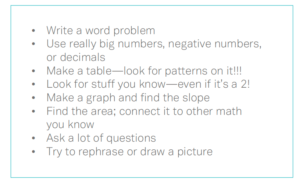
Figure 3. Ways to meet our warm-up goals. Student-generated list of approaches to generate ideas about a warm-up problem in math classes.
Another way that I collaborated with students was in sharing data from our weekly survey. One week, my data showed a significant drop in the question “This week I felt challenged in a good way,” as shown in Figure 4. From my observations, I knew the students had all been working hard on their portfolios all week and revising old assignments, so I couldn’t understand why the drop in student perception had happened. The improvement team suggested I show the run chart to the students and see what they had to say about it.
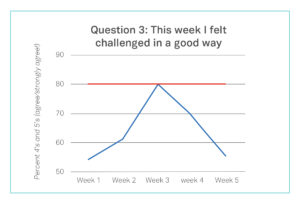
Figure 4. Sarah’s students’ perception of challenge from week 1 to week 5. Students reported a drop in their perception of challenge in Sarah’s math class from Week 3 to Week 5.
The students provided insight to me that, because they didn’t learn anything “new” and instead were just revising old work, the week didn’t “feel” hard. I was able to not only explain the rationale for having weeks like this, but also hear from them about how we could ensure that their brains were still working hard (like having a warm-up with a new idea or a short lecture at some point during the week).
In the end, improvement science and our entire network helped me identify new ways of collecting data about my students. Furthermore, sharing the data back with students can lead to changing ideas and classroom shifts that are even more impactful than anything I had considered.
Improvement moving forward
The High Tech High team, in conjunction with our students and the broader ASCENT network, is still on the journey of improving math education at our schools. Although the ASCENT network is no longer meeting together regularly, many math teachers in our organization have continued to use the improvement structures we’ve learned and regularly share data collection routines with each other. As a result, teachers have broadly initiated survey routines with questions about agency, and many of us use weekly check-ins with our students. Improvement science and the ASCENT network afforded us the collaborative space, structures, and data to see that the work we are doing is gaining momentum around both student agency and access to college.
In bringing improvement science into our own teaching practice, we have had shifts in the educational discussions about what was going in our classrooms.
For other teachers hoping to have similar progress, we recommend the following:
• Start collecting data right now (and define data broadly). Often collecting data seems cumbersome and time-consuming, but a quick exit card, tracking how many times students share during class discussions, or noting how many ideas students generate during a warm-up routine are all ways to gather quick data and get an interesting snapshot of your class. Just make sure the data collection aligns with what you value for your students!
• Find one or two teachers to collaborate with regularly, and do it now. Once you have a quick data collection tool you like, get another teacher to collect data as well. Find a short period of time (even only 10 minutes) to share data together weekly and unpack what students are saying and doing, according to your data collection. Use each other as sounding boards to plan next steps.
• Bring student voice into your data collection and analysis as often as possible. Sharing that data back with students can help them be clear about your hopes and expectations for the class and encourage them to seek improvement and progress in things like collaboration, brainstorming, quality work, and their sense of agency. Sharing graphs and raw data both is a powerful lever for change and helps give students a voice in the design and trajectory of the class.
This work has helped us to clarify exactly what we want math to be at the High Tech High schools: an open and creative subject all about connections and growth. Short incremental changes with regular data sharing sessions with the broader network, each other, and students made this work manageable and exciting, and truly accelerated our improvement process. We hope it will for you as well.
Citation
Strong, S., Hollenbeck, C., and Haase, W. (2019). Improving mathematics at High Tech High with improvement science. Kaleidoscope: Educator Voices and Perspectives, 6(1), 14–21.
